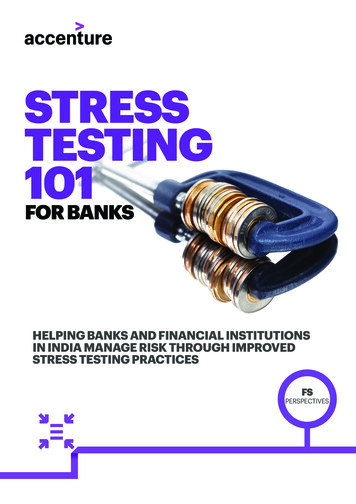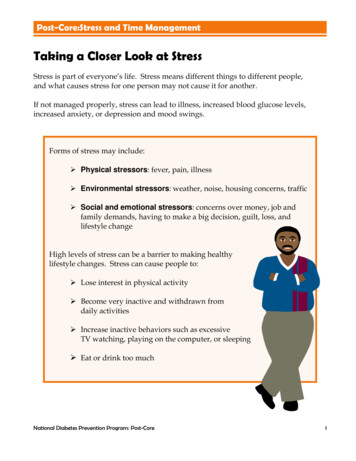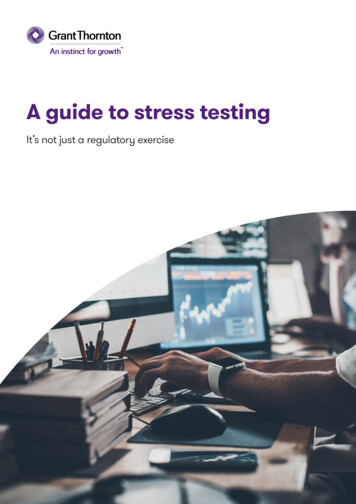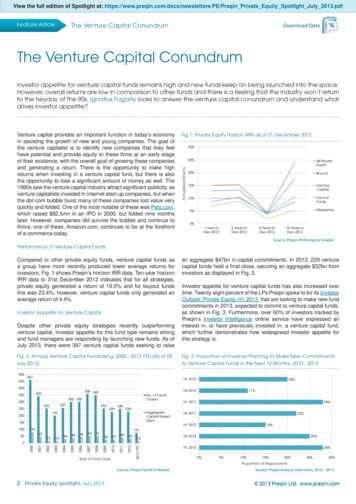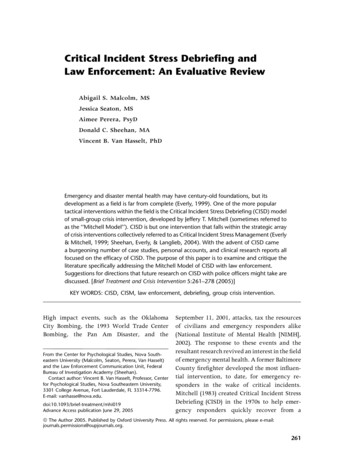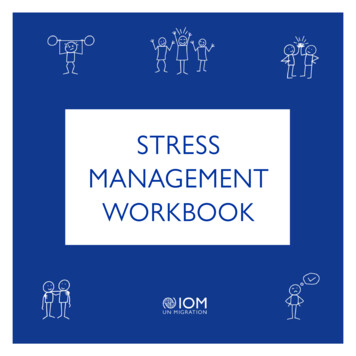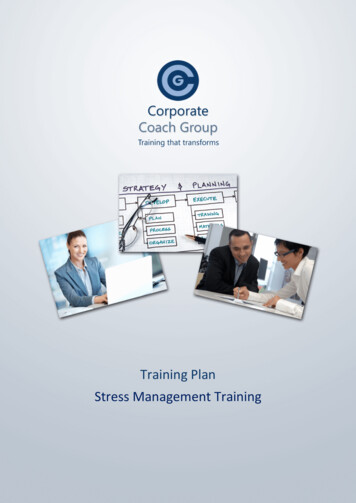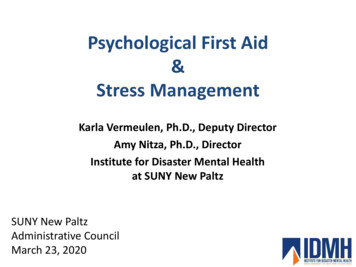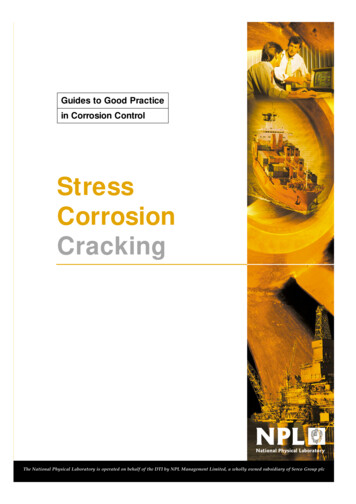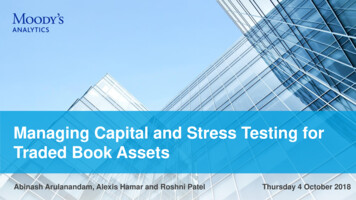
Transcription
Managing Capital and Stress Testing forTraded Book AssetsAbinash Arulanandam, Alexis Hamar and Roshni PatelThursday 4 October 2018
AgendaKey elements for discussion1.Overview and the current market demands2.Impacts for trading book assetsa.Fundamental Review of Trading Book - Linkage to Incremental Risk Charge (IRC) and Default Risk Charge(DRC)b.Risk coverage3.Focus on Reverse Stress Testing4.Q&AManaging Capital and Stress Testing for Traded Book Assets2
1Overview and the currentmarket demands
Market trendsTraditionally, analysis of trading book and banking book is viewed as distinct from the analysis of the different nature anddynamics of risks.However, some joint dynamics are required to capture the emergence of collateral riskNEW PARADIGM FOR TRADED ASSETS More Regulatory emphasis on economic risks of traded assets treated Risk and Emergence of Collateral Risk – Spread Risk - Settlement Risk – Wrong Way Risk Stress Testingreinforcement in context of ICAAP and future FRTB rulesCONSOLIDATED VIEWGroup structures require a strong coordination of activities aimed to: Set rules for estimation of traded assets and banking books at group level. Have a consolidated and consistent view of the Group risk profile Increase the efficiency of risk-capital allocation over the entire Group perimeter Risk Appetite and Hedging Strategies ImplementationExploring both Regulatory and Internal Risk Capital Concentration and correlation affects for concentration risk Capital allocation across both measures Trend to enhance and integrate measuresManaging Capital and Stress Testing for Traded Book Assets4
What is the market saying?Comments in 20181234Quantification soundnessCurrent approaches adopted by clients are viewed to not be quantitative, and are more expert orqualitatively based/driven. This is predominantly led by ICAAP findings and internal committee reviews.GovernanceThe banking book, its models have known to have strong governance frameworks but the trading bookneeds to have consistent and common governance structures, enhancing controls for models.Greater need for Validation / AuditRevisions to regulation, models and feedback on prior regulatory submissions has meant greaterinteractions for internal / external validation and providing Auditors with proof on the submissions.Global / LocalThe need for global consistency but accounting for local nuisances and how to manage branches,subsidiaries and group level consolidations. Common reporting and model framework.Managing Capital and Stress Testing for Traded Book Assets5
The financial crisis and the regulatory evolutionon Trading BookCapital Volatility forTrading AssetsBasel 2.5Issues posedby regulatorsAdvantage of InternalModels vs StandardVaR and credit risk inFinancialthe Trading BookCrisisLow sensitivity to2007 - Subprime extreme eventsCrisisBanking Book vsTrading Book Arbitrage2008 - DefaultLehmanBrothers2010 - EuropeanSovereign debtcrisisStressed VaRIRC/CRMHypo vs ActualBacktestingImpact of Basel2.5Capital charge for widerasset classes (i.eSovereignIncrease of capitalrequirement for InternalModelBanking Book vs TradingBookNext evolution:FRTB Basel 4Expected Shorftall /Liquidity HorizonRegulator imposedcorrelationsMarket dynamicsrepresentationNews for ModelValidationPnL AttributionBacktestingValidation of IMM atDesk levelFloor Standard Method /Reduction of gapInternal Model vs StdDefault Risk Charge(DRC)Market VaR RWAArbitrage betweenBanking and TradingBookComprehensiveRisk CoverageModel Validation forComplex andStructured InstrumentsManaging Capital and Stress Testing for Traded Book Assets6
Banking & Trading BooksCommon Components and al MarginCommercial MarginCollateral ValueAdjustmentFunds Transfer PriceSpread Risk PremiumConcentration Premium»Option SpreadNew Accounting standards toimpact both Pricing and RegulatoryCapital landscapesCapital Value AdjustmentFunding ValueAdjustmentFunding Liquidity Spread»CET 1 increases due to IFRS ruleswill reduce upcoming FRTBrequired onesCredit Spread Residual»Common Components - SpreadRisk across Trading and BankingBooksReference RateMargin Value AdjustmentCredit Value AdjustmentReference RateManaging Capital and Stress Testing for Traded Book Assets7
2Fundamental Review ofTrading BookLinkage to DRC and IRC
FRTB ImplementationStrategy/profitabilityDesk reorganisation(eligible desks)Senior ManagementFront officeInvestmentsGovernanceBanking BookDesk1Desk2IRTdeskDesk nWell definedboundaryTrading BookInternal Model Approach (IMA)Standardized ApproachFront officeExpectedShortfallMiddle office/datamanagementTechnologyDEFAULT RISKCHARGENMRFSensitivity basedchargeDefault riskchargeResidual risk addon Risk factor identification Intraday limit monitoring Inventory ageing reports BB & TB segregation for instruments P&L reports Disclosures Monte Carlo Farms Distributed Computing Data WarehousingManaging Capital and Stress Testing for Traded Book Assets9
Stress Testing Emphasis in FRTB»Stress Testing is a transversal imposed practice–Stressed calibration period (period of significant financial stress) for Expected Shortfall–Liquidity Horizon : no price movement for instrument hedging in stressed period–Curvature in Standardized approach is estimated through 2 stress scenarios per risk factors–Non Modellable Risk factors where there is a stress capital charge–Default Risk Charge : Based on a 1 year period of stress taken from a 10 year historical data using a 250 Liquidity Horizon“Stressed” period means:–12 months period of stress over the observation horizon in which the portfolio experiences the largest loss–Span at least back to 2007–Observation equally weighted–At least an update once a month–And updates done as soon as there is a significant move in the marketManaging Capital and Stress Testing for Traded Book Assets10
IRC PrinciplesCoverageRisk Mitigation andDiversification»Long/Short Positions»Hedging StrategiesOptionality»Non Linear relationshipsMigration»Spread and Ratings»060501IRCPRINCIPLES040302Debt edit & IR DerivativesConcentration Risk»Issuer and Market lation between default& migrations»Capture Listed, Unlisted, Emerging Markets& Sovereign correlationsManaging Capital and Stress Testing for Traded Book Assets12
Proposed Architecture (Example for DRC)Risk ManagementIntegration ServicesFront OfficeData Integration ServicesCorrelation ModelReferenceDataReference PortfoliosStress TestingModelHypothetical PnLSensitiviesCoordinator1Shared Temp4SecurityDefault RiskCharge andScenario AnalysisClientdeal/staticData8Distributed SimulationFront Office Desk Users6Staging andNormalizedDatabase3Full SimulationAggregated PortfolioViewTheoritical PnL75Market DataNear Real TimeWhat-if (Incremental Risk, PnL)Reference PortfolioStage2Managing Capital and Stress Testing for Traded Book Assets13
FRTB, DRC – Correlation pain pointCorrelation is one of the pain points due to modelling complexity, data requirements and inclusion of equities in FRTBGranular level that allows client to better understand risk in theirportfoliosFRTB REQUIREMENTSMODEL Correlation model is a requirementMulti-factor model allows to capture different aspects of firms, economyand the relevant relations Correlation needs to be measured over aliquidity horizon of one year 10 years of data satisfying FRTB requirements and providing robustestimates Validation of correlation model must be inplacePartner with external vendor or create a combined external and internaldata model Choice & weights of systematic riskfactors must be well documented andvalidatedDATA Calibration to at least 10 years of data Equity data must be included Must include periods of stress Objective and transparent dataWhat banksare lookingforSovereigns included with state of the art methodology due to scarce dataCorporate correlations included in model ensuring maximumcompletenessExtensive research in model development for different sectorsData cleaning not needed on the client’s side, painless bind with systemRecognized vendor ensuring quality, standards and support if neededManaging Capital and Stress Testing for Traded Book Assets14
IRC vs DRC SummaryTopicsIRCDRCScopeIR Instruments (Bonds, Sovereigns,CDS) Equities (optional)IR Instruments EquitiesModeling ApproachVaR 1 year @99.9%VaR 1 year @99.9%Default RiskMulti-Factor approach2 types of Factor ApproachCorrelations horizon3 years10 years including a 12 months ofstressCorrelations sourceAny (asset returns, equity returns, cdsspreads)Based on CDS spreads and equityreturnsMigration RiskIncludedExcluded. Included in Spread RiskLiquidity Horizons3 month or 1 year horizon1 year and 60 day for EquityPDNo floor3 bps floorLGDDeterministic, stochastic (optional)Stochastic and correlated tosystematic factorsManaging Capital and Stress Testing for Traded Book Assets15
2bOther risk types
Counterparty Credit Risk considerationsMulti-period Valuation»Valuation (optionality and pricingproxies etc)»Credit Migration and Spread RiskEffects»Liquidity Value adjustments/ fundingliquidity adjustmentsCorrelationPortfolio Models» Risk Factor Analysis (multi factorasset correlation models)»Monte Carlo simulation approximations»CVA VaR and allocation»Re/calibration» Cross asset correlation (IR, Credit,FX etc)»Benchmarking» Wrong way risk (general)»Back-testing» Stress testing and scenarioconstruction» Wrong way risk (specific)Modeling ConsiderationsStrategy and Business Considerations» Best practices processes» Data, System infrastructure and reporting requirements» Front office (FO) vs CCR model reconciliation» CVA Hedging» Capital Optimisation» Integration of loan and trading portfoliosManaging Capital and Stress Testing for Traded Book Assets17
Wrong Way Risk» Wrong-Way Risk–An unfavourable dependence between exposure and counterparty credit quality: the exposure is high when the counterparty is more likely to default andvice versa.» General Wrong-Way Risk–Arises when the probability of default of counterparties is positively correlated with general market risk factors.» Specific Wrong-Way Risk–Arises when the exposure to a particular counterpart is positively correlated with the probability of default of the counterparty due to the nature of thetransactions with the counterparty.» Wrong Way Risk includes the following ingredients:–Joint simulation of Market-Credit factors–Utilizes Economic Portfolio Models as it is designed by nature with correlations effects–Migration, Default and to some extent Recovery for systematic LGD–Conditional scenarios–Funding Spread in FVAManaging Capital and Stress Testing for Traded Book Assets18
Wrong Way Risk and correlations» There are two types of correlation to consider:– The correlation between the underlying asset and the counterparty of the trade.– The correlation between the trades.» A firm has to typically take into account both types of correlation.» The correlation between the instrument and trade counterparty can increase (WWR/wrong wayrisk) or decrease (RWR/right way risk) the capital requirements.» Example of an use cases (other use cases also available:Correlation (Counterparty and underling asset)Bank A position on the underling assetRisk (wrong way risk/ right way risk)Case 1Case 2PositiveNegativewill receive will deliver will receive will deliverRWRWWRWWRRWRManaging Capital and Stress Testing for Traded Book Assets19
Settlement Risk»Settlement risk is the risk that one party will fail to deliver the terms of a contract with another party at the time of settlement.»In Europe, there is a growing trend to see more quantification of the settlement risk capital and its impact considering netting,correlations and at different distributions.»Regulators want to explore all the other traditional risk types»Settlement risk can create a loss if the underlying asset value moves against the agreed price.–In Delivery vs Payment (DvP) contracts: the loss is the replacement cost.Example»Firm A buys 1 Apple share at 100 from Firm B.Firm BPrice of Apple Share (settlement date)Profit»No-default9510500Default955105-5To measure settlement risk it is key to capture the joint likelihood of counterparty default and the change in the value of the underlyingreference asset.Managing Capital and Stress Testing for Traded Book Assets20
3Focus on Reverse StressTesting
What Regulators say about Reverse Stress Testing ?The Basel committee paper on principles forsound stress testing practices and supervisionpromoted a comprehensive stress testingapproach in banks, the concept of ReverseStress Testing.EIOPA -Solvency Pilar 2 ORSA Introduction –Reverse Stress TestingPRA provides more explicitstatements on Reverse StressTesting20142009Further to the AQR and EBAstress tests, SREP reverse stresstesting requirements are publishedUpdate on ICAAP and SREPEIOPA – ORSA reinforcesReverse Stress Testinginclusion20162015Solvency 2 Go Live includingsome requirements onReverse Stress Testing20182017EIOPA study on market andcredit riskQuantification elements forinclusionManaging Capital and Stress Testing for Traded Book Assets22
Reverse Stress Testing: Trends123Reverse Stress Testing – Nothing new In the UK, this has been around for a number of years, Europe has become more advanced and developed, a new re-focus Require firm to assess scenarios and circumstances that would render its business model unviable More understanding for the ICAAP submission as per regulatory requirementsCore elementsDetermining scenarios Be able to macroeconomic variable related terms for loss points defined Explore idiosyncratic weaknesses Uncover which risks contribute the most to expected loss and capital and use that information to design plausible stress scenarios For instance By how much does GDP have to fall for my portfolio to lose 10% in value?Example approach Range of qualitative and quantitative approaches to determine those weaknesses Explore correlations between credit risk factors and macroeconomic variables to help draw impacts Different risk types will also have different triggers, look at asset class specific influences Leverage macro-scenario approach, which is key input for the firm to explore cause of trigger points. Estimating conditional mean of the risk factors and macro variables conditional on portfolio loss exceeding a given loss level Reducing dimension of risk and macro factors by ranking the most influential risk/macro factors that determine losses Solving for the inversion problem to find the set of risk/macro factors values with regards to the hypothetical scenario (the most likelyscenario)Managing Capital and Stress Testing for Traded Book Assets23
Q&A
Appendix
Joining the Building BlocksBANKING BOOKRISK DUE TO DEFAULTRISK DUE TO CREDIT MIGRATIONRISK DUE TO SPREAD RISKCREDIT RISKRISK DUE TO SPREADRISKTRADING BOOKRISK DUE TO MARKET RISK»»RISK DUE TO CCRChallenges in setting the correlation between credit risk, market risk, spread riskand CCRCOUNTERPARTY CREDITRISKCONSOLIDATED RISKSpread Risk presence in both trading and banking books and unique counting–Margin Period of Risk – Settlement Risk–Migration Risk - SpreadManaging Capital and Stress Testing for Traded Book Assets26
Advantage of an Integrated SolutionBetter captures diversification – more accurate capital numbersA SINGLE CREDIT RISK SYSTEMRISK DUE TO DEFAULTINTEGRATED RISKRISK DUE TO CREDIT MIGRATIONfrom an Integrated Modelof Risk FactorsRISK DUE TO SPREAD RISKRISK DUE TO MARKET RISKRISK DUE TO CCR»Ability to set more accurate and granular risk correlation parameters»Straightforward risk decomposition»Avoids double counting»Improved operational efficiencyManaging Capital and Stress Testing for Traded Book Assets27
Credit Risk FrameworkStandardized ApproachDRC – Internal Model ApproachCredit VaR based approach :3 sub-portfolio to be considered:»»»»»»»»»Stochastic LGD and 0% recovery for equitiesDependance of recovery rates and systematic risk factors2 types of systematic factors for simulating defaultsCorrelations based on equity prices or CDS spreadsFloored PD @3bpsOne year liquidity horizon and 60 day for EquitiesModeling of the Default Risk by Jump-to-default (JTD)»»The new default risk charge should capture the risk arisingfrom long/short positions from the timing of defaults withina one-year capital horizon :»For example a long 1-year bond position hedged with a 3monthCDS should take into account loss scenarios generated by theissuer defaulting between months four and twelve months.Non SecuritizationSecuritization-Non CTP incl. its hedgesSecuritization-CTP incl. its hedgesLGD equity, non senior debt 100%; LGD senior debt 75%, LGDcovered bonds 25%Limitation in terms of seniority for offsetting positions (long/short) : Nettingis allowed only if short position has the same seniority of the long one» JTD (long) Max {LGD X Notional PnL; 0}» JTD (short) Max {LGD X Notional PnL; 0}» RW default risk weight * JTDWts σσ 𝐽𝑇𝐷 𝑙𝑜𝑛𝑔𝐽𝑇𝐷 𝑙𝑜𝑛𝑔 σ 𝐽𝑇𝐷 𝑠ℎ𝑜𝑟𝑡DRC Charge Non Securitization (by bucket) M𝐚𝐱 [ 𝑹𝑾𝑙𝑜𝑛𝑔 net JTD - 𝑾𝒕𝑺 * 𝑹𝑾𝒔𝒉𝒐𝒓𝒕 net JTD, 𝟎]DRC Charge Securitization CTP (by bucketed DRCb) M𝐚𝐱 [ [Max[DRCb,0] 0.5 x Min [DRCb,0],0]Managing Capital and Stress Testing for Traded Book Assets28
Modeling Credit Correlations Using Macroeconomic Variables is alsoCore to Understand Portfolio-Specific Tail Risk under Stress The parameters to be estimated are the entries of the correlations matrix linking macroeconomic variables and systematic creditrisk factors, as well as correlations among macroeconomic variablesφMVsΣ curent covariancematrix?MVsφCorrelations ofsystematic factors andmacroeconomicvariables (MVs):Define metrics andtarget survival valuesPerform tail risk fy unviablescenarios & hiddenvulnerabilitiesEnterprise –widesensitivity analysisTake actions andcreate contingencyplansManaging Capital and Stress Testing for Traded Book Assets29
Counterparty Credit RiskRiskFrontier in conjunction with GCorr Macro and a market risk system can be used to constructWrong Way Exposure, along with the portfolio referent risk of each particular counterparty.1)Run RiskFrontier with GCorr Macro and the Expected Exposure Profile (from market system that accounts for netting)2)Using the MC Output (which provides trial-by-trial detailed distributions on exposure and factor level) one can calculate the expected WW PDand expected WW market factor realizations conditional on the portfolio realizing losses in the region of the capital threshold3)Compute WW Exposure using the market risk system along with the expected WW market factor from step (2)4)Calculate portfolio referent risk of each counterparty using WW Exposure from (3)5)In some cases the WW Exposure is substantial and may impact the capital threshold to the point where steps (1)-(4) need to be iterated, withthe WW Exposure replacing Expected exposure in step (1)Expectedshock φMVconditional onportfolio lossMarket RiskSystemCalculatesWrong WayExposureWrong WayExposureanalyzed inRiskFrontierManaging Capital and Stress Testing for Traded Book Assets30
Expanded GCorrTM and Macro Variables Covariance Matrix:Modeling OverviewExpanded Cov. MatrixMapping MV and MV FactorsInputsRiskFrontier TMMC SimulationEngineMV MC Trial-by-Trial FileTrialOutputsSimulated macroeconomicfactorsSimulated GCorrTM systematiccredit risk factorsPortfolio Loss1φMV1, φMV2, φ1, φ2, L2φMV1, φMV2, φ1, φ2, LScenario Analysis: Impact MVon LossesStress TestingReverse Stress TestingEconomic scenarioSpecified loss levelLossesEconomic scenariosAnalysis*For further information: “Modeling Credit Correlations using Macro Economic Variables”, Nihil Patel, RPC 2012Managing Capital and Stress Testing for Traded Book Assets31
Workflow : Easy Upload and Selection of Trials Upload RF Outputs: generated the loss distribution correlated factor file Define the tail trial windows enteringprobability levels or a single probability and awindow size.Managing Capital and Stress Testing for Traded Book Assets32
Workflow: Set the starting macro environmentManaging Capital and Stress Testing for Traded Book Assets33
Workflow: Factor and MV Tail Mean Analysis4. Trials Sorting in R or Excel5. Attribution Reports – Outputs Factor Means Macro and Financial Variable Means Macro and Financial Variable Density»Conditional Systematic Factor Ranking Tail Mean»Conditional Macro and Financial Variables TailMean»Macro and Financial Variable Density ProbabilityManaging Capital and Stress Testing for Traded Book Assets34
Scenarios that Generate a Loss Level» The key to this approach is an approximation of theportfolio loss function 𝐿𝐻 𝑟 as a linear function of assetreturns.» The linearization is done around the asset returns 𝑟ҧ thatgenerate the pre-defined loss level 𝐿ത .» We can then analytically search for the scenarios that givethat level of loss» We need the Monte Carlo output around the pre-definedManaging Capital and Stress Testing for Traded Book Assetsloss level to identify the asset returns𝑟.ҧ35
Scenarios that Generate a Loss LevelExample» Consider a well-diversified portfolio made of US and Canadian exposures.» We want macroeconomic scenarios that lead to a loss of 6% of mark-to-modelvalue in this portfolio at a 1-year horizon.–This loss level corresponds to the 47bp percentile of the loss distribution.–Analysis date: 30/09/2016.» We focus only on scenarios with the following macroeconomic variables:–US Unemployment, US Equity, US VIX, US BBB Spread, Canada Equity, Canada Unemployment, Oil Price.Managing Capital and Stress Testing for Traded Book Assets36
Scenarios that Generate a Loss LevelExample: Focus on the scenario with a 6% loss levelAnalysis DateAverage ScenarioQ3-2016Q3-20174.9%10%10025US VIX13.3439.87US BBB Spread1.85%9.36%Canada Equity10033Canada Unemployment7%20.51%Oil Price10041Macroeconomic VariableUS UnemploymentUS EquityThe scenarios should lead to a conditional loss distribution whoseexpected loss is close to the desired level of lossPercentilesTargetExpected ConditionalLoss672 bp2%4%154 bp4%6.33%46 bp6%8.19%Managing Capital and Stress Testing for Traded Book Assets37
Reverse Stress Testing UtilityAutomationThe utility automates and streamlines the reverse stress testing process from RF Outputs to Tail Factor Analysis.Factor and Macro Variable Sensitivity ApproachSystematic and Macro/financial Macro Variables detailed Tail Mean AnalysisTransparencyValidation and Audit Analysis including Tail Trials, MV Returns, GCorr Factor MappingGovernanceFrequency of Updates wrt GCorr Models, Macro Levels update and Quality ChecksFast CalculationUses R code and Excel Macros for Trial Sorting that can be performed in few minutes.Managing Capital and Stress Testing for Traded Book Assets38
2018 Moody’s Corporation, Moody’s Investors Service, Inc., Moody’s Analytics, Inc. and/or their licensors and affiliates (collectively, “MOODY’S”). Allrights reserved.CREDIT RATINGS ISSUED BY MOODY'S INVESTORS SERVICE, INC. AND ITS RATINGS AFFILIATES (“MIS”) ARE MOODY’S CURRENTOPINIONS OF THE RELATIVE FUTURE CREDIT RISK OF ENTITIES, CREDIT COMMITMENTS, OR DEBT OR DEBT-LIKE SECURITIES, ANDMOODY’S PUBLICATIONS MAY INCLUDE MOODY’S CURRENT OPINIONS OF THE RELATIVE FUTURE CREDIT RISK OF ENTITIES, CREDITCOMMITMENTS, OR DEBT OR DEBT-LIKE SECURITIES. MOODY’S DEFINES CREDIT RISK AS THE RISK THAT AN ENTITY MAY NOT MEETITS CONTRACTUAL, FINANCIAL OBLIGATIONS AS THEY COME DUE AND ANY ESTIMATED FINANCIAL LOSS IN THE EVENT OF DEFAULT.CREDIT RATINGS DO NOT ADDRESS ANY OTHER RISK, INCLUDING BUT NOT LIMITED TO: LIQUIDITY RISK, MARKET VALUE RISK, ORPRICE VOLATILITY. CREDIT RATINGS AND MOODY’S OPINIONS INCLUDED IN MOODY’S PUBLICATIONS ARE NOT STATEMENTS OFCURRENT OR HISTORICAL FACT. MOODY’S PUBLICATIONS MAY ALSO INCLUDE QUANTITATIVE MODEL-BASED ESTIMATES OF CREDITRISK AND RELATED OPINIONS OR COMMENTARY PUBLISHED BY MOODY’S ANALYTICS, INC. CREDIT RATINGS AND MOODY’SPUBLICATIONS DO NOT CONSTITUTE OR PROVIDE INVESTMENT OR FINANCIAL ADVICE, AND CREDIT RATINGS AND MOODY’SPUBLICATIONS ARE NOT AND DO NOT PROVIDE RECOMMENDATIONS TO PURCHASE, SELL, OR HOLD PARTICULAR SECURITIES.NEITHER CREDIT RATINGS NOR MOODY’S PUBLICATIONS COMMENT ON THE SUITABILITY OF AN INVESTMENT FOR ANY PARTICULARINVESTOR. MOODY’S ISSUES ITS CREDIT RATINGS AND PUBLISHES MOODY’S PUBLICATIONS WITH THE EXPECTATION ANDUNDERSTANDING THAT EACH INVESTOR WILL, WITH DUE CARE, MAKE ITS OWN STUDY AND EVALUATION OF EACH SECURITY THAT ISUNDER CONSIDERATION FOR PURCHASE, HOLDING, OR SALE.MOODY’S CREDIT RATINGS AND MOODY’S PUBLICATIONS ARE NOT INTENDED FOR USE BY RETAIL INVESTORS AND IT WOULD BERECKLESS AND INAPPROPRIATE FOR RETAIL INVESTORS TO USE MOODY’S CREDIT RATINGS OR MOODY’S PUBLICATIONS WHENMAKING ANINVESTMENT DECISION. IF IN DOUBT YOU SHOULD CONTACT YOUR FINANCIAL OR OTHER PROFESSIONAL ADVISER.ALL INFORMATION CONTAINED HEREIN IS PROTECTED BY LAW, INCLUDING BUT NOT LIMITED TO, COPYRIGHT LAW, AND NONE OFSUCH INFORMATION MAY BE COPIED OR OTHERWISE REPRODUCED, REPACKAGED, FURTHER TRANSMITTED, TRANSFERRED,DISSEMINATED, REDISTRIBUTED OR RESOLD, OR STORED FOR SUBSEQUENT USE FOR ANY SUCH PURPOSE, IN WHOLE OR IN PART,IN ANY FORM OR MANNER OR BY ANY MEANS WHATSOEVER, BY ANY PERSON WITHOUT MOODY’S PRIOR WRITTEN CONSENT.All information contained herein is obtained by MOODY’S from sources believed by it to be accurate and reliable. Because of the possibility of humanor mechanical error as well as other factors, however, all information contained herein is provided “AS IS” without warranty of any kind. MOODY'Sadopts all necessary measures so that the information it uses in assigning a credit rating is of sufficient quality and from sources MOODY'S considersto be reliable including, when appropriate, independent third-party sources. However, MOODY’S is not an auditor and cannot in every instanceindependently verify or validate information received in the rating process or in preparing the Moody’s publications.NO WARRANTY, EXPRESS OR IMPLIED, AS TO THE ACCURACY, TIMELINESS, COMPLETENESS, MERCHANTABILITY OR FITNESS FORANY PARTICULAR PURPOSE OF ANY SUCH RATING OR OTHER OPINION OR INFORMATION IS GIVEN OR MADE BY MOODY’S IN ANYFORM OR MANNER WHATSOEVER.Moody’s Investors Service, Inc., a wholly-owned credit rating agency subsidiary of Moody’s Corporation (“MCO”), hereby discloses that most issuers ofdebt securities (including corporate and municipal bonds, debentures, notes and commercial paper) and preferred stock rated by Moody’s InvestorsService, Inc. have, prior to assignment of any rating, agreed to pay to Moody’s Investors Service, Inc. for appraisal and rating services rendered by itfees ranging from 1,500 to approximately 2,500,000. MCO and MIS also maintain policies and procedures to address the independence of MIS’sratings and rating processes. Information regarding certain affiliations that may exist between directors of MCO and rated entities, and between entitieswho hold ratings from MIS and have also publicly reported to the SEC an ownership interest in MCO of more than 5%, is posted annually atwww.moodys.com under the heading “Investor Relations — Corporate Governance — Director and Shareholder Affiliation Policy.”Additional terms for Australia only: Any publication into Australia of this document is pursuant to the Australian Financial Services License ofMOODY’S affiliate, Moody’s Investors Service Pty Limited ABN 61 003 399 657AFSL 336969 and/or Moody’s Analytics Australia Pty Ltd ABN 94 105136 972 AFSL 383569 (as applicable). This document is intended to be provided only to “wholesale clients” within the meaning of section 761G of theCorporations Act 2001. By continuing to access this document from within Australia, you represent to MOODY’S that you are, or are accessing thedocument as a representative of, a “wholesale client” and that neither you nor the entity you represent will directly or indirectly disseminate thisdocument or its contents to “retail clients” within the meaning of section 761G of the Corporations Act 2001. MOODY’S credit rating is an opinion as tothe creditworthiness of a debt obligation of the issuer, not on the equity securities of the issuer or any form of security that is available to retailinvestors. It would be reckless and inappropriate for retail investors to use MOODY’S credit ratings or publications when making an investmentdecision. If in doubt you should contact your financial or other professional adviser.Additional terms for Japan only: Moody's Japan K.K. (“MJKK”) is a wholly-owned credit rating agency subsidiary of Moody's Group Japan G.K., whichis wholly-owned by Moody’s Overseas Holdings Inc., a wholly-owned subsidiary of MCO. Moody’s SF Japan K.K. (“MSFJ”) is a wholly-owned creditrating agency subsidiary of MJKK. MSFJ is not a Nationally Recognized Statistical Rating Organization (“NRSRO”). Therefore, credit ratings assignedby MSFJ are Non-NRSRO Credit Ratings. Non-NRSRO Credit Ratings are assigned by an entity that is not a NRSRO and, consequently, the ratedobligation will not qualify for certain types of treatment under U.S. laws. MJKK and MSFJ are credit rating agencies registered with theJapan Financial Services Agency and their registration numbers are FSA Commissioner (Ratings) No. 2and 3 respectively.MJKK or MSFJ (as applicable) hereby disclose that most issuers of debt securities (including corporate and municipal bonds, debentures, notes andcommercial paper) and preferred stock rated by MJKK or MSFJ (as applicable) have, prior to assignment of any rating, agreed to pay to MJKK orMSFJ (as applicable) for appraisal and rating services rendered by it fees ranging from JPY200,000 to approximately JPY350,000,000.MJKK and MSFJ also maintain policies and procedur
Counterparty Credit Risk considerations Multi-period Valuation Portfolio Models Correlation » Valuation (optionality and pricing proxies etc) » Credit Migration and Spread Risk Effects » Liquidity Value adjustments/ funding liquidity adjustments » Wrong way risk (specific) » Monte Carlo simulation approximations » CVA VaR and allocation
